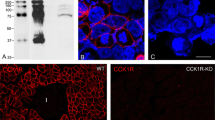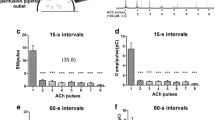Summary
Incubation of rat pancreatic lobules for 90 min with optimal concentrations of caerulein, carbachol or secretin caused the release of about 30% of the amylase content. Combination of secretin with carbachol or caerulein increased the amylase output to about 40%. With secretin, as with carbachol or caerulein, heterogeneity of cellular responsiveness was observed, some acini being partially or completely depleted of their zymogen granules, whereas others appeared to be resting. When secretin was combined with carbachol or caerulein, granule depletion, originally confined to small groups of neighbouring acini, spread to form large areas of degranulated cells, sometimes comprising a whole section of a lobule.
In dispersed acini, under the same conditions, carbachol caused the release of about 60% of the amylase content, and secretin 40%. When both secretagogues were combined, a significant increase to 78% was observed. Under these conditions, there was some important cellular damage, as indicated by the release of 20% of the amylase content and between 6 and 12% of lactate dehydrogenase into the media, in the absence of stimulus. These results were corroborated by cytological observations. On the basis of their secretory response two groups of acini can be distinguished, those that respond to carbachol, caerulein or secretin and those that respond to the combination of secretin with carbachol or caerulein. Electrophoretic patterns of secretory proteins released by lobules stimulated by these different types of secretagogues were essentially similar. The pattern was quite different, however, in the absence of a stimulus. The most striking feature was the presence of a band at 63 Kd whereas a 73.5 Kd band was found only under conditions of stimulation. The latter results support the view that under resting and stimulated conditions secretory proteins are released from distinct compartments in the acinar cell.
Similar content being viewed by others
Abbreviations
- PMSF:
-
phenylmethylsulfonyl fluoride
- Carbachol:
-
carbamylcholine chloride
- SBTI:
-
soybean trypsin inhibitor
References
Beaudoin AR, Vachereau A, St-Jean P (1983) Evidence that amylase is released from two distinct pools of secretory proteins in the pancreas. Biochim Biophys Acta 757:302–305
Bieger W, Kern HF (1975) Studies on intracellular transport in the rat exocrine pancreas. I. Inhibition by aromatic amino acids in vitro. Virchows Arch (Path Anat) 367:289–305
Bernfeld P (1955) Amylase, α and β. In: Colowick SP, Kaplan NO (eds) Methods Enzymol Academic Press New York pp 149–158
Case RM (1978) Synthesis, intracellular transport and discharge of exportable proteins in pancreatic acinar cell and other cell. Biol Rev 53:211–354
Collen MJ, Sutliff VE, Pan G-Z, Gardner JD (1982) Postreceptor modulation of action of VIP and secretin on pancreatic enzyme secretion by secretagogues that mobilize cellular calcium. Am J Physiol 242(5):G423-G428
Demetriou JA, Drewes PA, Gin JB (1974) Enzymes. In: Henry RJ, Canon DC, Winbelmann JW (eds) Clinical chemistry: Principles and technics. Harper & Row, Hagerstown, Maryland, p 819
Deschodt-Lanckman M, Robberecht P, De Neff P, Labrie F, Christophe J (1975) In vitro interactions of gastrointestinal hormones on cyclic adenosine 3′5′-monophophosphate levels and amylase output in the rat pancreas. Gastroenterology 68:318–325
Gardner JD, Jensen RT (1983) Characterization of receptors for gastrointestinal peptides. Scand J Gastroenterol 18 (Suppl 83): 7–18
Geuze HJ, Slot JW, Van der Ley PA, Scheffer RCT (1981) Use of coloidal gold particles in double-labelling immunoelectron microscopy of ultrathin frozen tissue sections. J Cell Biol 89:653–665
Iwanij V, Jamieson JD (1982) Biochemical analysis of secretory proteins synthetized by normal rat pancreas and by pancreatic acinar tumor cells. J Cell Biol 95:734–741
Laemmli UK (1970) Cleavage of structural proteins during the assembly of the head of bacteriophage T4. Nature (Lond) 227:680–685
Lee PC (1979) Effect of CCK-octapeptide and secretion on amylase secretion in isolated rat pancreatic acinar cell. Digestion 19:6–14
Lewis DS, MacDonald RJ, Kronquist KE, Ronzio RA (1977) Purification and partial characterization of an integral membrane glycoprotein from zymogen granules of dog pancreas. FEBS Letters 76:115–120
Luft JH (1961) Improvements in epoxy-resin embedding methods. J Biophys Biochem Cytol 9:409
MacDonald RJ, Ronzio RA (1972) Comparative analysis of zymogen granule membrane polypeptide. Biochem Biophys Res Commun 49:377–382
Pâquet MR, St-Jean P, Roberge M, Beaudoin AR (1982) Isolation of zymogen granules from rat pancreas and characterization of their membrane proteins. Eur J Cell Biol 28:20–26
Peikin SR, Rottman AJ, Batzri S, Gardner JD (1978) Kinetics of amylase release by dispersed acini prepared from guinea pig pancreas. Am J Physiol 235(4):E743-E749
Phaneuf S, Grondin G, Roberge M, LeBel D, Lord A, Beaudoin AR (1984) Cytological effects of ionophore-induced stimulation on the exocrine pancreas of the rat. Cell Tissue Res 235(3): 699–701
Roberge M, Beaudoin AR (1982) Newly synthetized secretory proteins from pig pancreas are not released from a homogeneous granule compartment. Biochim Biophys Acta 716:331–336
Roberge M, Grondin G, Larose L, Beaudoin AR (1981) Cytological effects of urecholine stimulation on the rat pancreas. Cell Tissue Res 220:781–786
Sato T, Shamoto M (1973) A simple rapid polychrome stain for epoxy embedded tissue. Stain Techn 48:223–227
Scheele GA (1975) Two-dimensional gel analysis of soluble proteins. Characterization of guinea pig exocrine pancreatic proteins. J Biol Chem 250(14): 5375–5385
Scheffer RCT, Poort C, Slot JW (1980) Fate of the major zymogen granule membrane-associated glycoproteins from rat pancreas. A biochemical an immunochemical study. Eur J Cell Biol 23:122–128
Slot JW, Geuze HJ (1983) Immunoelectron microscopic exploration of the Golgi complex. J Histochem Cytochem 31 (8):1049–1056
Trowell OA (1959) The culture of mature organs in a synthetic medium. Exp Cell Res 16:118–147
Author information
Authors and Affiliations
Rights and permissions
About this article
Cite this article
Phaneuf, S., Grondin, G., Lord, A. et al. Electrophoretic and cytological evidence for heterogeneity of pancreatic acinar cell responsiveness to carbachol, caerulein and secretin. Cell Tissue Res. 239, 105–109 (1985). https://doi.org/10.1007/BF00214909
Accepted:
Issue Date:
DOI: https://doi.org/10.1007/BF00214909




